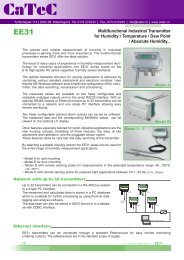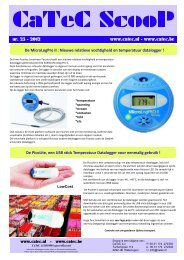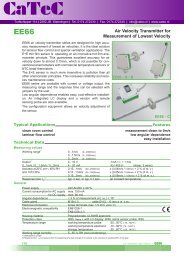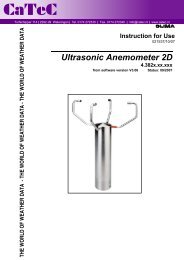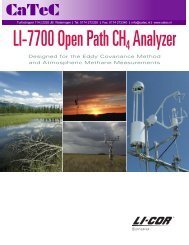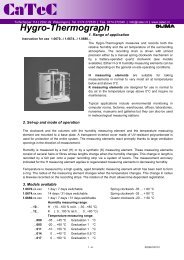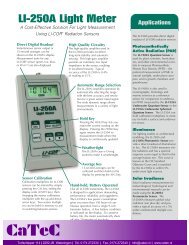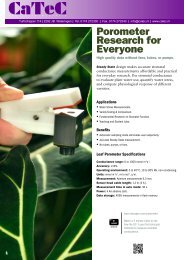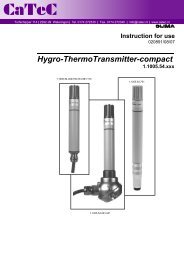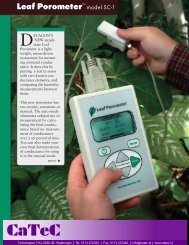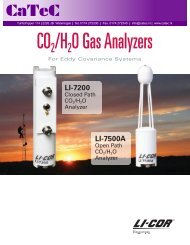soil moisture
soil moisture
soil moisture
- No tags were found...
You also want an ePaper? Increase the reach of your titles
YUMPU automatically turns print PDFs into web optimized ePapers that Google loves.
new Instruments Available. Details inside.
newnewCanopyLeaf Porometer & Steady-State TechnologyLP-80 Ceptometer: Measure PAR & LAILeaf Wetness Sensor: Built-to-orderSoil MoistureDecagon Soil Moisture Systems IntroductionSoil Moisture SensorsGS3, EC-5, 10HS, 5TE, 5TM, MPS-2.Environmental Sensors & ProCheckCup Anemometer, PYR/PAR Photon Flux Sensor,RT-1, Temp RH, ECRN-50/100.Em50 Series Data LoggersDataTrac 3: Complete Soil Moisture AnalysisEm50G Webviewer: Data On The GoIrrigation ManagementWater BalanceWater Potential Soils113577910111314151618newnewnewnewnewWP4C Water Potential DataField Water Potential MonitoringT8 Tensiometer, TS1, T4, T5/T5x, MPS-2,Infield 7 Data Collector.Mini Disk Infiltrometer: Soil Hydraulic ConductivityHyProp: Create SWCC Using Natural EvaporationHyProp-Fit: WP Data Evaluation SoftwareVSA: Vapor Sorption Analyzer For Soil IsothermsHydrologyDrain Gauge G2/G3CTD Sensor: Continuously Monitor GroundwaterPore Water SamplersSK20, SIC20, SPE20.Vacuum SystemsThermalKD2 Pro: Model Heat MovementKS-1, SH-1, RK-1, TR-1.ReferenceWater Potential and Microorganism Growth LimitsDistribution and Customer Service181920212224252528293031313335
PorometerResearch forEveryoneHigh quality data without fans, tubes, or pumps.Steady State design makes accurate stomatalconductance measurements affordable and practicalfor everyday research. Use stomatal conductanceto evaluate plant water use, quantify water stress,and compare physiological response of differentvarieties.Applications• Water Stress Measurements.• Variety Testing & Comparison.• Fundamental Research on Stomatal Function.• Teaching and Student Labs.Benefits• Automatic sampling mode eliminates user subjectivity.• Accurate Steady-State measurement.• No tubes, pumps, or fans.Leaf Porometer SpecificationsConductance range: 0 to 1000 mmol m -2 s -1 .Accuracy: ±10%.Operating environment: 5 to 40ºC, 10 to 90% RH, non-condensing.Units: mmol m -2 s -1 , m 2 s mol -1 , s/m.Measurement: Aperture measurement 6.3 mm.Sensor head cable length: 1.2 m (4 ft.).Measurement time in auto mode: 30 s.Power: 4 AA alkaline cells.Data storage: 4095 measurements in flash memory.learn.decagon.com/porometerWatch a 3 minute video to seehow the SC-1 uses first-principlemethods to measure stomatalconductance.1
Mathematics of the SteadyState PorometerFRONT: INSIDE LOOKCANOPYDecagon’s Steady State Porometer measuresstomatal conductance using a sensor headwith a fixed diffusion path to the leaf. Itmeasures the vapor concentration at twodifferent locations in the diffusion path.It computes vapor flux from the vaporconcentration measurements and the knownconductance of the diffusion path using thefollowing equation:LeafTopR vsC VLR 1C V1Humidity SensorsAgitation BeadWhere C vL is the vapor concentration at theleaf, C v1 and C v2 are the concentrations atthe two sensor locations, R vS is the stomatalresistance, R 1 is the resistance betweenthe leaf and the first sensor, and R 2 is theresistance between the two sensors. If thetemperatures of the two sensors are the same,vapor concentration can be replaced withrelative humidity, givingConductance is the reciprocal of resistance, sonew2
PhotosyntheticallyActive Radiation &Leaf Area Index.CanopyMeasurementsPAR /LAIMeasure PAR and LAI with the AccuPar LP-80 Ceptometer.Use PAR Data to estimate biomass production withoutdestroying the crop (see details at right). Measurephotosynthetically active radiation (PAR) and get leafarea index (LAI) values simultaneously in real time. Storeapproximately 9000 data points manually by pressing abutton or automatically in unattended sampling mode.learn.decagon.com/LP80Watch a two minute video on measuringPAR and LAI with the AccuPar LP-80.AccuPAR LP-80 SpecificationsOperating environment: 0 to 5°C, 0 to 100% relative humidity.Probe length: 86.5 cm.Number of sensors: 80.Overall length: 102 cm (40.25 in).Microcontroller dimensions: 15.8 x 9.5 x 3.3 cm (6.2 x 3.75 x 1.3 in).PAR range: 0 to >2,500 µmol m -2 s -1 .Resolution: 1 µmol m -2 s -1 .Minimum spatial resolution: 1 cm.Data storage capacity: 1MB RAM, 9000 readings.Unattended logging interval: User selectable, between 1 and 60 minutes.Instrument weight: 1.22 kg (2.7 lbs).Data retrieval: Direct via RS-232 cable.Power: 4 AA Alkaline cells.External PAR sensor connector: Locking 3-pin circular connector (2 m cable).Extension cable option: 7.6 m (25 ft).Included Accessories3• External PAR sensor.2 meter cable with connector for direct connection to theceptometer’s external port. Calibrated to provide an output ofabout 0.1 mV per µmol m -2 s -1 (calibration label provided).• RS-232 cable.For interfacing between your computer and the AccuPAR.• Carrying case.Polyethylene hardened case with custom foam cutouts allowthe instrument and its accessories to be safely stored inside.3.6 kg, 11.8 x 24 x 109 cm.
TOTAL DRY MATTER (Mg/ha)252015105BarleyApplesSugar BeetsPotatoesCANOPY00.0 0.50 1.0 1.5INTERCEPTED SOLAR RADIATION (GJ/m2)86.5 cmNondestructive Biomass PredictionThe conversion of light energy and atmospheric carbon dioxideto plant biomass is fundamentally important to both agriculturaland natural ecosystems. The detailed biophysical and biochemicalprocesses by which this occurs are well understood. At a less detailedlevel, though, it is often useful to have a simple model that can beused to understand and analyze parts of an ecosystem. Such a modelhas been provided by Monteith (1977). He observed that whenbiomass accumulation by a plant community is plotted as a functionof the accumulated solar radiation intercepted by the community, theresult is a straight line. Figure 1 shows Monteith’s results.learn.decagon.com/assimilationFor more information view thefree virtual seminar “ModelCarbon Assimilation By Plants.”4
Built-to-orderLeaf WetnessSensorDetect leaf wetness duration with a sensitive,calibrated, standardized sensor.Many diseases affect plants only when<strong>moisture</strong> is present on the leaf surface. TheDielectric Leaf Wetness Sensor determinesthe presence and duration of wetness ona leaf’s surface, enabling both researchersand growers to forecast disease and protectplant canopies. The Decagon Leaf WetnessSensor approximates the thermal mass andradiative properties of leaves to closelymimic the wetness state of a real leaf.Because the sensor does not take resistancebased measurements, it requires no paintingor user calibration, and has the ability todetect ice formation as well.Applications• Disease forecasting and modeling.• Ecological and agricultural research.SpecificationsMeasurement time: 10 ms.Power: 2.5 VDC @ 10 mA to 5 VDC @ 7 mA.Output: 250 to 1500 mV.Operating environment: -20 to 60°C.Expected lifetime: 2+ years continuous use.Probe dimensions: 1.2 x 5.8 x 0.075 cm (4.4 x 2.3 x 0.029 in)Cable length: 5 m standard, custom length available.Connector type: 3.5 mm plug.Data logger compatibility: (not exclusive) – Decagon Em50,Em50R, Em50G, Campbell Scientific CR10, 10X, 21X, 23X, 1000,3000, 5000.5
High resolution sensor distinguishesbetween frost, dew and rain.CANOPY1200PROBE OUTPUT (RAW COUNTS)11001000900800700600500400FrostDewRainfallWetness ThresholdFrost30072 72.5 73 73.5 74 74.5 75TIME (DAYS)Because ice has a much lower dielectric content than that of liquid, the sensor output from frost will bemuch lower than that from a similar amount of rain or dewWhen read with the Em50 data logger, the LWS outputs 445 rawcounts when dry. When the sensor is totally wet, as in heavy rain,the signal can range up to around 1400 counts. Varying amounts ofwater on the surface will cause sensor output proportional to theamount of water on the sensor’s surface.learn.decagon.com/LWSWatch a 4 minute video on theunique measuring capabilities ofthe Leaf Wetness Sensor.6
Soil Moisture SystemsBig Networks for Big Science.Available SensorsSee the new rugged <strong>soil</strong><strong>moisture</strong> sensor line plusstandard <strong>soil</strong> <strong>moisture</strong>probes and a range ofabove-ground sensors.n Electrical interface for all sensors:3.5mm plug or 3-wire.n All sensors plug and log withDecagon Data Loggers.n All Sensors are compatible withmost CSI Data Loggers. Call to verifycompatibility.Data LoggersHassle-free access to yourdata—set up the loggerand start logging in lessthan 30 minutes.Details on page 11SoftwareDataTrac 3 provides youwith an almost real-timegraphical picture of yourdata.Details on page 13Details on page 97
Your <strong>soil</strong> <strong>moisture</strong>, delivered.1245SOIL MOISTURE3Image: DataTrac 3 software screenshot 11 KNOWKnow the status of the loggersin your network. When youclick on a logger in the devicetree, you’ll see all of the datafrom the logger, the batterylevel, and the transmissionstrength.2 MANAGEManage your wirelessnetwork. The device treelets you organize yourloggers for quick dataaccess.4 CREATECreate meaningful metricssuch as daily light integraland vapor pressure deficit.3 SHAREShare data with colleagues.When you allow colleaguesto subscribe to your datastream, they can view alldata and download a copyfor analysis.5 LEARNLearn what’s driving changesin <strong>soil</strong> <strong>moisture</strong> by seeingall of your metrics on onegraph.8
Soil Moisture SensorsMeasurement & Benefits Range Accuracy5.5 cmnewGS3Volumetric Water Content,Electrical Conductivity,Dielectric Permittivity,Temperature.Benefits:Optimized for greenhouse andnursery substrates.VWC: 0–100%.Apparent dielectricpermittivity (ε a ):1 (air) to 80.EC: 0 to 23 dS/m (bulk).Temperature: -40 to 50ºC.(ε a ): ±1 ε a (unitless) from1–40 (<strong>soil</strong> range), ±15% from40-80.EC: ±10% from 0 to 10 dS/m,user calibration required above10 dS/m.Temperature: ±1ºC.EC-5Volumetric Water Content.Benefits:All purpose, least expensive <strong>soil</strong><strong>moisture</strong> sensor.VWC: 0–100%.VWC: ±3%, typical mineral<strong>soil</strong>s up to 8 dS/m.VWC Rockwool:±3% VWC, 0.5 to 8 dS/m.5cmVWC Potting <strong>soil</strong>:±3% VWC, 3 to 14 dS/m.10HSVolumetric Water Content,Dielectric Permittivity.VWC: 0–57%.VWC: ±3%, typical mineral<strong>soil</strong>s up to 8 dS/m.Benefits:Largest volume of influencedecreases effects ofheterogeneity.Apparent dielectricpermittivity (ε a ):1 (air) to 50.(ε a ): ±1 from ε a of 2 to 10.±15 from ε a of 10 to 50.10cm5 cm5TEVolumetric Water Content,Electrical Conductivity,Dielectric Permittivity,Temperature.Benefits:Manage salts and fertilizers inyour system.dependencies inyour study.VWC: 0–100%.Apparent dielectricpermittivity (ε a ):1 (air) to 80.EC: 0 to 23 dS/m (bulk).Temperature:-40 to 50ºCVWC: ±3%, typical mineral <strong>soil</strong>sup to 8 dS/m.(ε a ): ±1 ε a (unitless) from 1–40(<strong>soil</strong> range) ±15% from 40–80.Bulk EC: ±10%.Temperature: ±1ºC.5 cmnew5TMVolumetric Water Content,Dielectric Permittvity,Temperature.Benefits:Include temperature dependenciesn your research study.VWC: 0–100%.Apparent dielectricpermittivity (ε a ):1 (air) to 80.Temperature:-40 to 50ºC.VWC: ±3%, typical mineral <strong>soil</strong>sup to 8 dS/m.(ε a ): ±1 ε a (unitless) from 1–40(<strong>soil</strong> range) ±15% from 40–80.Temperature: ±1ºC.3 cmMPS-2Soil Matric Potential, Temperature.Benefits:Maintenance-free water potentialand <strong>soil</strong> temperature monitoringmeasurements that do not driftover time.Soil water potential (Ψ):-10 to -500kPa(pF 1.71 to pF 3.71).Temperature:-40°C to 50°C.Ψ: ±25% of reading from-5 to -100 kPa*Temperature: ±1ºC.*Accuracy significantly improvedwith custom calibration.9
Environmental SensorsCharacterize the environment above the <strong>soil</strong> surface.Cup AnemometerThe anemometer measures both wind speed(using windcups and a magnetic switch) andwind direction (with wind vane). Includessealed stainless steel bearings for long life.The range and accuracy specifications of thisunit have been verified in wind-tunnel tests(information available upon request).Resolution: 1 mph (0.45 m/s).Range: 0 to 129 mph.Accuracy: ±5%.Pyranometer Model PYR/PARPhoton Flux SensorCompletely water proof, submersibleand designed for continuous outdoor use.Cable length: 1 m.Range PAR: 0 to 2000 µmol/m 2 s.Range PYR: 0 to 1750 Wm -2 .Dimensions: 24 mm diameter, 29 mm deep.Accuracy: ±5%.RT-1The rugged RT-1 <strong>soil</strong> temperaturesensor is an easy-to-use sensor formeasuring the temperature of <strong>soil</strong>or other materials. The sensor isstainless steel, completely waterproof, submersible, and designed forcontinuous outdoor use.Resolution: 0.1°C.Range: -40 to 80°C.Temperature accuracy: ±1°C.Type: Thermistor.Output: 320–1000 mV @ 3V excitation.SOIL MOISTURETemp RHECRN-50ECRN-100Durable sensor measures relative humidityand temperature, and outputs both values asdigital signals.Probe RH range: 0 to 100% RH.Temperature range: -40 to 60°C.Temperature accuracy: ±1°C.RH accuracy: ±2% from 10–90% RH, ±3% from0–10% RH, and 90–100% RH.Small self-emptying rain gaugefor measuring irrigation events orprecipitation.Resolution: 1 mm.Funnel size: 5x10 cm.High-resolution rain gauge with twointernal tipping spoons.Resolution: 0.2 mm.Funnel size 17x14.2 cm.ProCheckIndispensable tool for large installations.This staff favorite allows you to:• Check sensors quickly duringinstallation. Know if the installation isgood before you start backfilling.• Troubleshoot sensors in the field.• Program SDI-12 addresses.All sensors are plug-and-logwith Em50 series data loggers.Details on page 1110
Data LoggersSpend more time with your data– not your data logger.Can it really be that easy?Just plug in any Decagon sensor, set your sensortype and measurement intervals using dropdown menus, and start logging data.Pre-programmedNo user programming necessary.Powered by5 AA Batteries. No external power source required.Weatherprooflearn.decagon.com/27minutesWatch Ross, a research associate, set up anEm50G without any preparation.No extra enclosure needed.SpecificationsData Logger: Universal Specifications.Channels: 5.Interface: Each channel can accept all digital,analog, or pulse Decagon sensors.Storage: >36,000 scans, each scanincludes logger name, date, time, and sensormeasurements.Scan interval: User configured from1 measurement/minute to 1 measurement/day(minimum Em50G scan interval every 5 minutes).Power: 5 AA batteries.Enclosure rating: IP55, NEMA3.11
Em50GOptionsCellular transmission worldwide,Direct Connect.StorageAutomatic logger storage (36,000 scans),Decagon data server, Local Datatrac 3storage with every download.Em50RWITH DATASTATIONOptionsRadio 900 MHz, Direct Connect.StorageLogger storage (36,000 scans),DataStation storage (1 MB), localDataTrac 3 storage with every downloadfrom DataStation or Direct Connect.ApplicationsLarge-scale and small-scale studies wheredaily access to data is advantageous.Studies with multiple researchers requiringaccess to the same data set.ApplicationsSmall-scale (less than 2 km 2 ) studieswith a central data collection location.Studies that do not have cellularcoverage.SOIL MOISTUREEm50OptionsDirect Connect.StorageLogger storage (36,000 scans), localDataTrac 3 storage with every download.ApplicationsStudies where data access is onlynecessary once or twice per year.12
Complete Soil MoistureAnalysis– DataTrac 3DataTrac 3 transforms endless columns and rows of raw data intomeaningful, easily-interpreted graphs.12TRY IT FREE!Download your Free 30-day trial.learn.decagon.com/datatrac364531Educate and inform yourteam efficiently. DataTrac3’s graphics reducethe time and expertiseneeded to understand<strong>soil</strong> <strong>moisture</strong> data.2Adjust date ranges, addor subtract data fromspecific sensors, andchange target bands toillustrate and explore yourfindings.3Watch your data in realtime. DataTrac 3 updatesautomatically while it’srunning and every time itstarts up.4Add notes and ideasto the data stream.Comments andreminders can help youmake sense of a growingseason’s data later.5Automatically collectdata from your Em50Gand Em50R loggers. Alldata—including manuallycollected data—will beautomatically organizedand added to your fileschronologically.6Use Growing Tools tocombine data streamsand track meaningfulindicators. For example,plot vapor pressuredeficit instead of justtemperature and humidity.Or track growing degreedays, plant availablewater, pore water EC, etc.13
Data On The GoDemo the free Em50G Webviewer.newSOIL MOISTUREWebviewer is free software with the following benefits:n View your Em50G data on any mobile device with internet.n Easily share up-to-date data with colleagues– no spreadsheets needed!n Check on your system anytime, anywhere.n Check most recent data and battery level from all of your loggers.n Data from the previous week is always shown on the graph for quick updates.n Share your data with anyone– without having to purchase additional software.Em50Gwebviewer.comAccess to your data has never been so easy.14
Manage IrrigationWithout Leaving Your DeskSee both how much water is in the <strong>soil</strong> and how much of that water is available to plants.Soil <strong>moisture</strong> sensors only measure volumetric water content. Use the matric potentialsensor to monitor plant water availability. Fast-response <strong>soil</strong> <strong>moisture</strong> sensors let you trackplant water use in real time and set an accurate full-point that minimizes wasted water.1Know when to turn the irrigation on andoff with customizable target zones.4123Image: DataTrac 3 software screenshot 12Track water in the root zonewith Decagon <strong>soil</strong> <strong>moisture</strong>sensors. Plant available wateris calculated automaticallywith DataTrac 3’s GrowingTools option.3Rain gauges and irrigationpressure switch data on thesame graph as <strong>soil</strong> <strong>moisture</strong>show how each event affectsthe water available to yourplants.4Focus on key stress levelswith the extended range waterpotential sensor.learn.decagon.com/vineyard15See how a viticulturist uses the new featuresin DataTrac 3 to maximize their yield.
Close Your Water BalanceWith precipitation, <strong>soil</strong> water storage, and deep drainage.Two tough components of the water balance are storage and deep percolation.Collect the data you need to calculate water input, storage, and drainage in thevadose zone. Measure deep drainage rather than estimating to reduce errors inwater balance calculation.7SOIL MOISTURE56Image: DataTrac 3 software screenshot 25Quantify drainage past the rootzone with the Drain Gauge G3.Water samples are also held inthe Drain Gauge’s reservoir forchemical flux calculations.6Add local precipitation datato your calculations for watercontributions to the root zone.7Measure <strong>soil</strong> water storage inthe root zone with 5TM. Sensorscan be placed throughout the<strong>soil</strong> profile to further quantify <strong>soil</strong>profile water storage.16
Essential Water Potential DataMake fast, accurate water potential measurements in the lab.Measure the water potential of <strong>soil</strong>, <strong>soil</strong>lesssubstrate, plant tissue, or any porousmaterial in 5 to 10 minutes.The WP4C measures water potential bydetermining the relative humidity of theair above a sample in a closed chamber(an AOAC-approved method, conforms toASTM 6836).Applications• Soil <strong>moisture</strong> characteristic curves.• Root zone water potential profiles.• Expansive <strong>soil</strong> characterization.• Leaf water potential.• Seed priming.• Seed water relations.New features• Precise Mode—verifies full equilibrium beforedisplaying a final reading.• Speedy Equilibration—new hydrophobic teflonimpregnated nickel alloy sample chamber coatingreduces equilibration time.• Finely-Tuned Adjustments—new algorithms allowprecision calibration and ±0.05 MPa (or better)accuracy.• Better Range and Accuracy—resolves temperaturesto a thousandth of a degree to push the functionalrange to -0.1 MPa.SpecificationsOperating environment: 5 to 43°C (41 to 110°F).Temperature control: 15 to 40°C ±0.2°C.Sensors: 1. Infrared temperature 2. Chilled-mirror dewpoint.Range: 0 to -300 MPa*.Accuracy: ±0.05 MPa from 0 to -5 MPa, ±1% from -5 to-300 MPa.Read time: Typically 5 to 10 minutes.Interface cable: Serial cable (included).Data communications: RS232 compatible, 8-bit ASCIIcode, 9600 baud, no parity, 1 stop bit.Weight: 3.2 kg (5.2 kg shipping weight).Universal power: 110-220V AC, 50/60Hz.Sample dish capacity: 7 ml recommended (15ml full) .25 plastic cups and 10 stainless steel cups includedCalibration standard: 0.5 molal KCl (-2.22MPa).WATER POTENTIAL SOILSnewlearn.decagon.com/WP4CWatch R&D scientist Dr. Doug Cobosdiscuss the advancements made withthe new WP4C.* WP4C will read to 0 MPa, but readings of samples wetter than -0.1 MPa willhave an increasing, and typically unacceptable, percentage of error.Some users may be able to make useful measurements in samples wetterthan -0.1 MPa using special techniques. For more information, see the WP4CUser Manual.18
WATER POTENTIAL SOILST8 TensiometerIncludes temperature measurement,water level indicator and external refilling option.TS1The world’s first smart tensiometer.Designed to be deployed and left in thefield, the TS1 logs water potential data, self refills,monitors temperature, and self-empties when thetemperature nears freezing to avoid damage.10-200 cmT4 TensiometerStandard tensiometerwith external refilling option.Field Water PotentialMonitoring20-200 cm22-200 cmUMS designs andmanufacturers tensiometersto make research easier.The pressure transducerbasedsensors allow forprecise measurement ofwater potential. A varietyof sizes give you optionsfor deployment fromfield to lab. Their newesttensiometer, the TS1, allowsyearlong field deploymentafter installation.Tensiometer SpecificationsRange: +100 to -85 kPa (-200 kPa T5x).Accuracy: ±0.5 kPa*.Resolution: 0.1 kPa.Hysteresis: typ. 0.1% FS.Stability over one year: typ. 0.5% FS.Sensor: Piezoresistive pressure transducer,overpressure max ±3000 hPa.Electronics: Wheatstone full bridge.Compatibility: Infield 7 and Campbell Scientificdata loggers.*This range is possible with the T5x only, dependingon refill.T5/T5x*Mini-tensiometersare essential for the measurementof water potential in small spaces such as<strong>soil</strong> columns, potted plants or laboratory water flow experiments.2-20 cm* With careful refilling the T5x can make measurements below -85 kPa.Infield 7 HandheldDigital display interfaceswith all UMS tensiometersfor quick data collection.MPS-2Water potential monitoring invadose zone, crop stress, waste waterdrainage studies, irrigation monitoringand control, and plant water availability.3 cmnewMPS-2 SpecificationsLength: 3 cm.Measurement: Soil matric potential.Range: ±25% of reading from -10 to -100 kPa*.Accuracy: ±25% of reading from -5 to -100 kPa.*Accuracy significantly improved with custom calibration.19
Measure SoilHydraulicConductivityQuantify spatial variability of <strong>soil</strong> hydraulicconductivity.Bubble chamberstopperSuction regulationtubeXBubblechamberWater movement in <strong>soil</strong> is spatially variable.The Mini Disk Infiltrometer is a quick wayto test hydraulic conductivity and infiltrationrates.BackpackableSmall, compact, and simple, the Mini DiskInfiltrometer is a true field instrument. It canbe tossed into a backpack with a bottle ofwater.Quick SetupJust fill the reservoir, set the suction, andstart measuring infiltration. You don’t haveto pre-saturate the disk.Straightforward CalculationsEnter infiltration and elapsed time data inthe included spreadsheet calculator to findhydraulic conductivity.ReliableBoth scientists and technicians have used theMini Disk Infiltrometer to design irrigationsystems, demonstrate hydraulic conductivity,evaluate erosion hazard, and gauge theimpact of forest fires.ChamberbarrierAcrylictubeWaterreservoirMariottetubeSintered stainless steeldisc encapsulated inelastomer baseHeight:32.7cmYHYDROLOGYSpecificationsTotal Length: 32.7 cm.Suction Range: 0.5 to 7 cm of suction.Water Volume for Operation: 135 mL.Diameter of Sintered Stainless Steel Disc:4.5 cm diameter, 3 mm width.20
Take a look inside HyPropHyPropCreate SWCC Using Natural Evaporation.Forget the pain of using pressure plates.Use HyProp to generate detailed <strong>soil</strong>-watercharacteristic curves.Just take your undisturbed sample, putthe sample in the instrument, insert themeasurement head, place the HyProp on thebalance, and in less than a week, you have adetailed <strong>moisture</strong> release curve.• Uses undisturbed <strong>soil</strong> samples.• Works in all <strong>soil</strong> types.• Bonus feature gives unsaturated hydraulic conductivityvalues for the <strong>soil</strong> sample.SpecificationsRange: +2 to -120 kPa / -250 kPa.Resolution: 0.001 kPa.Accuracy: ±0.15 kPa.Optional Laboratory ScaleSpecificationsMeasuring range: 0 to 2.5 kg.Resolution: 0.01 g.Accuracy: ±0.1 g.Interface: RS232See page 22 graphic (Right)21
Information Measurements Evaluation Fitting ExportFIT HYDRAULIC FUNCTIONSRetention Θ (pF)Conductivity K(pF)Conductivity K(Θ)5550VOL. WATER CONTENT %454035302520151050LOG 10 (K in cm/d)LOG 10 (K in cm/d)pF(–)pF(–)VOL. WATER CONTENT %Drying portion of the <strong>moisture</strong> release curve generated by HyProp combined with WP4C data.Curve Data Added dataCurve Fits for All WaterPotential DataHyProp-Fit Moisture Release Curve Software.HyProp-Fit makes it easy to use the HyPropwith the new WP4C to generate a complete<strong>moisture</strong> release curve and parameters foruse in modeling.newWATER POTENTIAL SOILSY SOILSPut all your data together.HyProp-Fit software takes data generatedby the HyProp, WP4C, tensiometer, or anyother water potential instrument and createsa <strong>moisture</strong> release curve.Generate curve fits based on van Genuchten,van Genuchten Bimodal, Brooks andCorey, and other models. HyProp-Fit findsthe optimal parameter sets without initialparameter guesses.learn.decagon.com/fullcurveWatch a short video on how the HyPropand WP4C work together.FreeDownloadHyProp-Fitlearn.decagon.com/hypropfit22
WATER CONTENT (g/100g)Isotherm generated by the VSABentonitePalouse BNM ClayWalla WallaRoyalL-<strong>soil</strong>252015105-500 -400 -300 -200-100 00WATER POTENTIAL (Mpa)Create Static and DynamicIsotherms AutomaticallyVapor Sorption Analyzer.learn.decagon.com/VSAWatch a video on innovative ways the VSAis being used in <strong>soil</strong>s applications.newWATER POTENTIAL SOILSGenerates up to 200 data points (waterpotential vs. water content) for bothadsorption and desorption within 24-48hours.The VSA works in the dry (-10 to -475MPa) range. Create automated <strong>soil</strong>-watercharacteristic curves and generate all thecorrelations with clay activity, surface area,and swelling potential.Hold humidity constant and look at the way<strong>soil</strong> takes up water into its crystal structure(2:1 clays) and monitor water contentchange over time.SpecificationsRange: -10 to -475 MPa.Accuracy: ±1 MPa or ±1%.Temperature operating range: 15 to 40°C.Size: W 25.4 x L 38.1 x H 30.5 cm (10x15x12 in.)Weight: 19 kg.Benefits• Rapid isotherm generation.• Fast expansive <strong>soil</strong> characterization.24
MonitorGroundwaterLeachingMeasure Deep Percolation Rates Directly.Determine the volume of water and chemicals draining from thevadose zone into groundwater. The Drain Gauge measures drainageflux in unsaturated <strong>soil</strong>s and collects <strong>soil</strong> water samples forchemical analysis.An ingenious duct and wick design maintains a flow rate within thegauge equivalent to that in surrounding <strong>soil</strong>. A surface port allowsyou to draw out samples to analyze for chemicals, fertilizers, andother contaminants.Applications• Waste landfill sites: advise operators when drainage is occurring and wherecover systems need to be improved.• Maximization of food processing waste applications; monitoring waterdrainage rates and water quality below the root zone.• Environmental research; measuring percolation and recharge rates.• Farming operations: measure and control irrigation during a cropping season.• Recreational facilities (such as golf courses): measure and control excesswater and nutrient losses.Drain Gauge G2Flow Through TechnologyInert material construction ofthe tube, sensors, and collectionreservoir inhibits chemical reactions.Measurement surface area: 324 cm 2 .Sampling reservoir volume: 150 mL.Accuracy: ±10%.Resolution: 0.1 mm drainageSuction at intake: 110 cm (11 kPa)Total length: 147 cmDivergence control tube (DCT)length: 60 cm.Measurement time: 10 ms.newDrain Gauge G3Sample Capture TechnologySurface port provides easy access todrainage/ temperature/ EC sensorfor maintenance.Measurement surface area: 507 cm 2 .Sampling reservoir volume: 3 L.Accuracy: ±10%.Resolution: 0.1 mm drainageSuction at intake: 110 cm (11 kPa)Total length: 147 cmDivergence control tube (DCT)length: 60 cm.Measurement time: 150 ms.25
HYDROLOGY26
Measure Conductivity,Temperature, and DepthContinuously monitor groundwater and surface water level changes along with electricalconductivity and temperature.Decagon’s CTD sensor puts much of its complex circuitry in an above-ground datalogger. This lowers the per-sensor cost without impacting accuracy and resolution.So instead of relying on a single measurement, you can measure in several differentlocations without exceeding your budget.newlearn.decagon.com/CTDWatch a video to learn more about thecapabilities of the CTD sensor.SpecificationsWater DepthRange: 0 to 3.5 m.Accuracy: ±0.2 % of span at 20˚C.Resolution: 1 mm.Electrical ConductivityRange: 0 to 120 dS/m (mS/cm).Accuracy: ±0.01 dS/m or ±10%.Resolution: 0.001 dS/m.TemperatureRange: -40 to +50°C.Accuracy: ±1°C.Resolution: 0.1°C.Data Logger CompatibilityEm50/Em50R/Em50G.Call for compatibility of Data Loggers.Features• Robust marine-grade epoxy overmold to resist corrosionin tough environments.• Compact 3.4 cm diameter sensor body to fit into tightspaces.• External logger with remote transmission option to deliverthe data directly to your desktop.• Permanent connection to collect data continuouslywithout pulling up the sensor.Applications• Aquifer recharge and recovery.• Saltwater intrusion, desalination, and wastewater.• Wetland monitoring.• Groundwater contamination monitoring.• Surface water monitoring.HYDROLOGY28
Pore Water SamplersDon’t take a <strong>soil</strong> core every time you want data.Leave your experimental site undisturbed and takemore meaningful pore water samples with UMS’spore water samplers.Applications• Quantify the presence of heavy metals,pesticides, and other contaminants.• Measure net mineralization rates.• Sample for organic carbon.SPE20Polyethylene Nylon MembraneSpecially suitable for heavy metals, herbicides, and pesticides.Shaft diameter: 20 mm; acrylic.Shaft length: 20 to 210 cm; customized to order.Porous ceramic: 20 mm diameter; 60 mm length.Bubble point: -100 kPa; but the PE cover allows water flow only up to -20 kPa.Suction tube: Polyethylene; 1.6 mm i.d.; 2.8 mm o.d.SK20Aluminum Oxide CeramicSuitable for determination of nitrate and common organic and inorganic substances.Shaft diameter: 20 mm; acrylic.Shaft length: 20 to 210 cm; customized to order.Porous ceramic: 20 mm diameter; 60 mm length.Bubble point: -100 kPa.Suction tube: Polyethylene; 1.6 mm i.d.; 2.8 mm o.d.SIC20Silicon CarbideAllows for sampling of a broad range of chemicals due to low sorption.Shaft diameter: 20 mm; acrylic.Shaft length: 20 to 210 cm; customized to order.Porous ceramic: 20 mm diameter; 60 mm length.Bubble point: -90 kPa.Suction Tube: Polyethylene; 1.6 mm i.d.; 2.8 mm o.d.29
Vacuum SystemsTensiometer control ensures accurate sample concentrations.How does it work?A pore water system is a quick accesspoint for extracting <strong>soil</strong> water. Rather thandigging up a chunk of <strong>soil</strong> and performingan extraction every time you want asample, you install a specially tipped tubein the <strong>soil</strong>. Soil water samples are gentlyextracted from <strong>soil</strong> pores using suctionpressure matched to natural <strong>soil</strong> watertension. Soil water tension is measured witha tensiometer; suction is set slightly abovethat tension to pull a sample.Eliminates Spatial VariabilitySampling in the same undisturbed locationevery time gives you better data.Uses Natural Sampling SuctionPrecisely controlled tension means yousample what’s actually in the <strong>soil</strong> water.Constant, unregulated tension preferentiallysamples the wet time periods, dilutingyour samples and giving inaccurateconcentrations. UMS’s unique tensiometercontrol matches sampler suction to thenatural suction of the <strong>soil</strong> as conditionschange, for the most accurate sampleconcentrations.Customized to Solute TypeUMS’s patented siliconecarbide tip is inertto a large range ofcompounds. Other tipsare also available.HYDROLOGYVacuPorterELECTRIC PUMPMax. vacuum: -85 kPa.Max. pressure: 400 kPa.Capacity: 10 liters/min.Battery capacity: Internal rechargeable battery;7 hours of operation.Case: 30 x 25 x 13 cm.Weight: 4.8 kg.Operating temperature: -10 to +45°C.VS/VS-Twin/VS-proPower supply: 10.5 to 15 VDC.Interface: tensioLINK, RS485.Memory: 5000 readings.Vacuum regulation range: 0 to -85 kPa.Dimensions: 26 x 16 x 10 cm.Enclosure: Aluminum.Operating temperature: -10 to +45°C.VPS-2Hand-Operated Floor PumpMax. vacuum: -85 kPa.Capacity: 0.41 liters per stroke.Material: Aluminum and stainlesssteel, steel foot.Height: 57 cmWeight: 2.2 kg.30
Model HeatMovementGet A Handle On Heat Transfer.Each KD2 Pro comes factory calibrated and includesperformance verification standards.Measure heat transfer in the <strong>soil</strong> plantatmosphere continuum with the KD2 ProThermal Properties Analyzer. The KD2 Pro hasthree interchangeable sensors which measurethermal conductivity, thermal diffusivity andspecific heat (heat capacity) along with datastorage capabilities and an automatic datacollection mode.KS-16 cm needle lengthThermal conductivity of liquids.The optional RK-1 sensor kit measures rock,concrete and other materials where drilling apilot hole is required.• Heated Needle Technology.• Requires No Calibration.• Displays in Engineering Units.• Small Needle Minimizes Soil Disturbance.SH-13 cm dual needle length3 parameters: thermal conductivity,thermal diffusivity, and specific heat.RK-1new6 cm needle lengthThermal conductivity/resistivity; for usewith stone or cement samples.Specifications:Measurement time: 90 Seconds to 10 minutes.Accuracy*: ± 5 to ± 10% Conductivity/Resistivity.± 10% Thermal Diffusivity, ± 10% Specific Heat.Ranges*: K: 0.02 to 4 Wm -1 C -1 , D: 0.1 to 1.0 mm 2 s -1 ,R: 0.5 to 50 mC W -1 , C: 0.5 to 4 MJ m -3 C -1 .Data storage: 4095 readings.Environment: –50 to 150°C.Case size: 15.5 x 9.5 x 3.5 cm.Power: 4 AA Batteries.Cable: 1 m.*Accuracy and measurement range vary with sensor type.learn.decagon.com/KD2proTR-110 cm needle lengthThermal conductivity or thermalresistivity of <strong>soil</strong> or porous materials.ASTM and IEEE compliant.Watch a three and a half minute video aboutmeasuring <strong>soil</strong> thermal conductivity with theKD2 Pro.31
THERMAL32
Water PotentialINSTRUMENT RANGESSTUDYLABORATORY INSTRUMENTSFIELD INSTRUMENTSMEASUREPressurePlate*HyPropTensiometerPlant Water StudiesEcological StudiesSoil Water & FlowIrrigation ManagementExpansive SoilsVSAPermanent WiltingPoint (-1.5 MPa)WP4CDewPointGranularMatricHeatDissipationMPS-2-1 kPa-10 kPa-100 kPa-1 MPa-10 MPa-100 MPa-1000 MPaHypoxia Plant Available Water Air DryOven DryExcellent accuracy.Good accuracy.Moderate accuracy.Responds to change, may not be accurate.Useful in some applications.Not recommended or out of range.33*Assumes equilibrium time 1-3 months.
Growth LimitsZoosporemovementceasesMotility ofbacteriaceasesMeanminimum tosupportbacterial growthLower limit ofplant availablewaterMicrocoleusgrowthinhibitedMicrocoleusphotosynthesisinhibitedNitrification andsulphur oxidationceaseBacterialrespirationceasesPseudomonasetc. inhibitedMICROORGANISMSpF*MPaWATER POTENTIALa WWATER ACTIVITY2.7 -0.05 0.99963.2 -0.14 0.99903.9 -0.70 0.99494.2 -1.50 0.98914.3 -1.80 0.98694.5 -2.80 0.97984.6 -4.20 0.96984.7 -5.00 0.96424.9 -7.03 0.9500Salmonella,some moldsinhibitedMany yeastsinhibited5.1 -12.92 0.91005.3 -19.08 0.8700Most moldsinhibitedMost halophiticbacteriainhibitedXerophilic moldsinhibited5.5 -30.57 0.80005.6 -39.41 0.75005.8 -59.02 0.6500All microbialproliferationceases5.9 -69.98 0.6000The biological limits are taken from L.R. Beuchat, Cereal Foods World,26:345 (1981) and M. Potts, Microbiological Reviews, 58:768 (1994).*pF is the base 10 logarithm of the water potential in cm34
35DistributorsAFRICASouth AfricaCS AfricaTel: 27 21 880 1252sales@csafrica.co.zawww.csafrica.co.zaMoroccoMETAGRYDTel: 212 522 254 900metagrhyd@gmail.comwww.metagrhyd.comASIAChinaEcotekTel: 86 10 51 665 551info@licorcn.comwww.ecotek.com.cnIndiaNu-Tech InternationalTel: 91-11-5467218info@nutechintl.comwww.nutechintl.comJapanAINEX Co., Ltd.Tel: 81 3 5713-0388info@ai-nex.co.jpwww.ai-nex.co.jpKoreaC & HTel: 82 2 501 3869info@candh.co.krwww.candh.netMalaysiaTMSTel: 603-5122-5108tms6009@tm.net.mywww.tms-lab.comRussiaLab Depot CorporationTel: 7 812 -320-60-48es@labdepot.ruwww.labdepot.ruTaiwanWilson Scientific Co. Ltd.Tel: 886 2 2690 7696wilsonn@tpts5.seed.net.twThailandWin Siam Co., Ltd.tel. 66 2910 9898winsiam@gmail.comwww.winsiam.comAUSTRALIA & NEW ZEALANDAustraliaICT International Pty. Ltd.Tel: 61 267 726 770sales@ictinternational.com.auwww.ictinternational.com.auEUROPEAustriaUMS GmbH MünchenTel: 49 89 1266 52 14ekotechnika@ekotechnika.czums@ums-muc.dewww.ums-muc.deBelgium/LuxembourgCaTeCTel: 31 174 272 330info@catec.nlwww.catec.nlCzech and Slovak RepublicsEkotechnika Spol. S.R.O.Tel: 420 737 044 323ekotechnika@ekotechnika.czwww.ekotechnika.czDenmarkInverva ApSTel: 45 6595 9454info@inverva.comwww.inverva.comFranceSols MesuresTel: 33 1 30 503 450info@sols-mesures.comwww.sols-mesures.comGermanyUMS GmbH MünchenTel: 49 89 1266 52 14ums@ums-muc.dewww.ums-muc.deGreeceScientact SATel: 30 2310 946 126info@scientact.com.grwww.scientact.com.grIcelandMeasurement SystemsTel: 354 661 1169sala@maelibunadur.iswww.maelibunadur.isItalyMisure SNCTel: 39 06 907 5535info@misure.netwww.misure.netNetherlandsCaTeCTel: 31 174-272330info@catec.nlwww.catec.nlPolandGeomor-Technik Sp. Z O.OTel: 48 91 482 00 90geomor@geomor.com.plwww.geomor.com.plRomaniaSC Terra Preta SRLTel: 40 746 020249office@terra-preta.rowww.terra-preta.roRussiaLab Depot CorporationTel: 7 812 -320-60-48es@labdepot.ruwww.labdepot.ruSpainCentro De AsesoríaDr. Ferrer, S.L.Tel: 34 93 371 05 16info@lab-ferrer.comwww.lab-ferrer.comSwedenToragon ABTel: 46 (0)90-100 260info@toragon.sewww.toragon.seTurkeyBilmarTel: 0312-468 28 35bilkim@bilmar.com.trwww.bilmar.com.trUnited KingdomLabcell Ltd.Tel: 01420 568 150mail@labcell.comwww.labcell.comMIDDLE EASTIsraelMeteo-TechTel: 97 2 3 616 0598info@meteo-tech.co.ilwww.meteo-tech.co.il
Support & Service509-332-5600support@decacgon.comTurkeyBilmar Bilimsel Arastirma veMühendislik A.S.Tel: 0312-468 28 35bilkim@bilmar.com.trMiddle East/North AfricaICT Intl. Middle EastTel: 962 7770 54400ghazi@ictinternational.com.auNORTH AMERICACanadaHoskin Scientific Ltd. (West)Tel: (604) 872-7894salesv@Hoskin.cawww.hoskin.caHoskin Scientific Ltd. (East)Tel: (905) 333-5510salesb@Hoskin.cawww.hoskin.caHoskin Scientififique Ltee.(Quebec)Tel: (514) 735-5267salesm@Hoskin.cawww.hoskin.caMexicoRuber Eim De MéxicoTel: 52 55 5653 3077rubereim@prodigy.net.mxwww.rubereimdemexico.comUSA & All othersDecagon Devices, Inc.Tel: 509 332 2756instruments@decagon.comwww.decagon.comSOUTH AMERICAArgentinaInstrumentos del Sur S.A.Tel: 54 11 4791–0169info@idelsur.comwww.idelsur.comBrazilDecagon Devices LatAm Ltda.Tel: 55 12 3307 1003contato@decagon.com.brwww.decagon.com.brCentral AmericaLAPACATel: (506) 8891-9895www.lapacacr.comChileMorpH2O L.A.Tel/fax (56 2) 821 6095www.morph2ola.comcontacto@morph2ola.comColombiaColtein Ltda.Tel: (571) 347 2038info@coltein.comwww.coltein.comPeruMorpH2O L.A.Tel: (56 2) 821 6095www.morph2ola.comcontacto@morph2ola.comToddVANEKCUSTOMER SUPPORT MANAGERTroubleshooting, Care and Maintenance,Research Design & Data Analysis,Measurement ProceduresNickMOWERSALES AND SERVICENew Instrument & accessories sales,measurement procedures, general inquiriesJordanTANASSECANOPY PRODUCTS MANAGERTroubleshooting, Care and Maintenance,Research Design & Data Analysis,Measurement ProceduresChrisCHAMBERSENVIRONMENTAL APPLICATIONS SCIENTISTTroubleshooting & measurement procedures,Research Design, Data Analysis
DECAGON DEVICES, INC.Data collected with pencilsprocessed with slide rules.Late 70’s Campbell Scientific developsinexpensive, portable battery operateddata loggers. Researchers no longerneed a camp trailer and extensioncords to record data.TDR revolutionizes <strong>soil</strong> <strong>moisture</strong>measurementsCommunications-ready loggers andlow cost <strong>soil</strong> <strong>moisture</strong> sensors makenetworks of 50, 100, even 1000 sensorpoints possible.1950’s 1976 1979 2012-PRESENTOne of my hobbies is collecting antiques. It’s an interesting hobby for someone whose day jobis all about innovation. Though I spend most of my time talking about what’s new, I alsoenjoy looking back.2012 marks Decagon’s 30th anniversary and it’s made me think about the progress in measuringthe environment over the last 30 years. I think there are three instrument-related developments thathave advanced environmental science:• Small, low-power data loggers with wireless communication capabilities.• Significant increases in computer processing power and speed.• Dielectric <strong>soil</strong> <strong>moisture</strong> sensors (TDR, FDR).These developments make it possible to scatter collection nodes across the landscape. Researcherscan now gather and analyze staggering amounts of data. Projects like B2 Landscape EvolutionObservatory at Biosphere 2 and the Site-Specific Climate Friendly Farming project at Cook Farmare beginning to show us what’s possible with these big networks.What’s next? It’s impossible to say, of course, but I’m excited to see what new measurements willmove the science forward. EC measurements, for example, are still somewhat crude but showpromise in refining the way we look at water and nutrient movement in <strong>soil</strong>sBryan WackerVICE-PRESIDENT MARKETING©2012 Decagon Devices, Inc.PRINTED IN THE USADecagon Devices, Inc.2365 NE Hopkins CourtPullman, WA 991631-509-332-5600instruments@decagon.comlearn.decagon.com



